Explore our rich history.
A Brief History by Church Archivist Michael A. Riester
St. Louis parish was founded on January 5th 1829 through the beneficence of Louis Stephen LeCouteulx de Caumont, a French nobleman, the first resident Catholic of Buffalo and agent of the Holland Land Company. In his New Years Gift to Bishop Jean Dubois of New York, LeCouteulx deeded land for the erection of a church, cemetery, school and priest house for all Catholics.
In 1831, Rev. John Nicolas Mertz, a missionary priest, arrived in the village of Buffalo, becoming the areas first resident priest. Fr. Mertz immediately set about organizing a school and the construction of a church. The new log church, hewn from logs in the nearby forests, was named ” Lamb of God” after the depiction of the Lamb of God on a tabernacle door that Fr. Mertz brought with him from Europe. In 1836, St. John Neumann joined Fr. Mertz in ministering to the growing number of German speaking Catholics who had settled in the outlying villages surrounding Buffalo.
In 1838, seven men incorporated themselves under the laws of New York State into a Board of Trustees, thereby assuming the temporal affairs of the parish. In 1843 a larger brick church was built on the site of the log church by Rev. Alexander Pax. This new church was dedicated to St. Louis IX, the patron saint of Louis LeCouteulx.
After the death of LeCouteulx, a fierce rivalry between rival factions in the parish ensued. Disagreements between the trustees and Bishop John Hughes of New York resulted in the parish being placed under Interdict in 1843. This ended a year later. In the late 1840’s, disputes again broke out between the trustees and Bishop Timon resulting in the parish again being placed under Interdict. This second Interdict lasted until 1855. Time proved a great healer under the guidance of Rev. Joseph Sorg who became pastor in 1867. Highly esteemed by his parishioners, Fr. Sorg was given a final resting place in the Church Hall.
On March 25, 1885, fire broke out in the newly erected German American Music Hall across Edward Street. Due to high gusty winds, flames soon spread to the roof of the brick church. Despite valiant attempts by both parishioners and firemen, the church was totally destroyed. The fire claimed the lives of fireman George Roth and parishioner Joseph Grimm.
The next day, plans were set in motion for the construction of a new church in a grand continental gothic style. The first donation was made by Rev. Joseph Sorg and matched by parishioner and successful businessman Gerhard Lang. To assist in fundraising efforts, men of the parish organized the St. Louis Dramatic Circle, one of the nation’s earliest amateur theatrical groups which produced plays including the Shakespearean tragedy Hamlet.
Designed by the architectural firm of Schickel & Ditmar, the present church was richly adorned by local woodworkers and sculptors. The local firm of Riester & Frohe designed the windows in the nave clerestory and the Royal Munich Art Institute executed the sanctuary windows depicting the life of St. Louis IX of France. Our beautiful spire is the highest open laced spire in the United States and is a focal point of our city’s skyline. Our Kimball Organ was installed in 1903.
To celebrate our 175th anniversary, the parish completed a successful restoration of our beautiful church and the creation of a parish archives and museum. Through the dedicated effort of parishioners and friends, St. Louis Church has a bright and promising future and will continue to embrace the vision of our founder Louis LeCouteulx as a spiritual home for all Catholics.
Description of the Present Church
Completed in 1889 by Schickel & Ditmar of New York City, the present Church is built in the continental Gothic style of the 14th century.
The exterior is of Medina red sandstone.
The ground plan is cruciform with naves, sanctuary and transept. The nave is divided by magnificent columns of polished granite with richly carved stone capitals.
The dimensions of the Church are:
- Exterior length, 234 feet
- Exterior width, 134 feet
- Height from ground to ridge of roof, 105 feet
- Length of transept, 120 feet
- Nave is 42 feet wide and 75 feet high in the clear
- Side aisles are 19 feet wide and 36 feet height with clear height at the intersection of the nave and transept, 76 feet
The vaulted ceiling is richly groined with ribbing having bosses of foliage of various designs at their intersection.
The principal front on Main St. is designed on grand proportions.
The chief tower which is without doubt one of the most artistic and elegant in the country, rises to a height of 245 feet.
There are 2 side towers each 128 feet high.
Of special interest on the exterior is the massive Seth Thomas (Tower) Clock. It was the gift of Hon. Elbridge G. Spaulding, the "Father of the Greenback," who resided directly across from the Church on Main Street.
The Interior
With 275 pews, the seating capacity is 1,900 however 2,000 persons can be accommodated.
Among the beautiful interior furnishings includes the splendid Kimball Organ acquired under Rev. Dr. Paul Hoelscher's pastorate in 1903 and the ornately carved pulpit with its relief of the four evangelists and statues of the doctors of the Church.
Beside the statues of Saint Anthony and Saint Francis (each carved from a single block of wood) is the marble Baptistery enclosed with ornate icon work.
The altars of Saint Joseph and Seven Dolors, the communion rail of Australian marble and the High Altar, a gift from Miss Emma Lang in 1898 were made by the Lautz Marble Works.
The Sacred Heart Altar was the gift of Gerhard Lang, and the Altar of the Blessed Mother a gift of Chas. And Suzanne Lautz.
Of special interest in the High Altar is the life-size statue of St. Louis surmounted in a niche above a beautiful ebony cross with the likeness of our crucified Lord in ivory.
On either side of the Tabernacle are two large mosaics. The one on the left represents Abraham about to sacrifice his son Isaac and the other on the right represents the offerings of Melchizedek.
St. Louis School
In addition to serving the WNY area with the Holy Sacraments, countless Buffalonians owe their primary education to St. Louis Church's school. As early as the 1830's a school was established at St. Louis as the parochial school in WNY. In 1850 the school building (directly behind the Church) was erected.
At its closing in 1959 it was the oldest educational institution continuously in existence in New York State. It was declared a hazard and torn down in 1986.
Who was St. Louis?
O God, who called your servant Louis of France to an earthly throne that he might advance your heavenly kingdom, and gave him zeal for your Church and love for your people: Mercifully grant that we who commemorate him this day may be fruitful in good works, and attain to the glorious crown of your saints; through Jesus Christ our Lord, who lives and reigns with you and the Holy Spirit, one God, forever and ever. – A Prayer to St. Louis
When our parish was founded in 1829, it was known as the Lamb of God. In 1843, with the completion of the new brick church, it was consecrated "St. Louis Roman Catholic Church" after the patron saint of our benefactor Louis Stephen LeCouteulx. As early as 1845, the parish had marked the Feast of Saint Louis, August 25th with festive liturgies and picnics.
Louis IX, was born at Poissy, France in 1214. He succeeded to the throne at the early age of twelve under the regency of his mother Blanche of Castille. Having married Margaret of Provence in 1234, he was the father of eleven children.
Louis, a follower of St. Francis of Assisi, was known for his ardent piety and sanctity. Unlike other Kings who gave customary offerings to the poor, Louis invited the poor to his own table each day, where he waited on them and attended to their needs. His personal interest in the poor led to the founding of numerous charitable institutions including hospitals for the destitute and lepers.
Known as the "Peace King", he managed to mediate between the popes and the German Emperors which kept France out of war. As a Ruler, he dispensed justice fairly and with great attention to the needs of his subjects. He was known for his scrupulous honesty.
Ardent to the Church of Rome, he collaborated with the Papal Inquisition which fought to enforce religious orthodoxy throughout his Realm.
Louis was also a great patron of the arts and architecture. During his reign, the famous Sorbonne Theological School was formed in Paris and the gothic jewel, the Sainte Chapelle in Paris, was built as his personal chapel. In the Sainte Chapelle, he enshrined the true Crown of Thorns which he had secured from the Emperor in Constantinople.
Louis led two Crusades to the Holy Land, both ending in catastrophe. On his first crusade, he was taken prisoner by Muslim forces in 1250 for which his countrymen were forced to pay a ransom. On his second crusade in 1270, Louis is credited as having restored the holy site at Tunis and having personally assisted in the burial of his dead soldiers.
Upon his death at Tunis in 1270, he was laid out on a bed of ashes in the shape of the cross.
Revered as a saint before his death, he was canonized by Pope Boniface VII in 1297.
St. Louis, the only King of France to be canonized, was recently hailed as the "the greatest of all Saint-Kings" by biographer Jacques LeGoff.
Museum & Archives
The St. Louis Church Museum opened in 2009. Our new museum and archives are rooted in the dedicated efforts of countless parishioners over the past 181 years to collect and preserve the living story that is St. Louis Church.
Through the generosity of the parishioners, the support of the trustees and encouragement of Msgr. Salvatore Manganello, planning for the state of the art museum and permanent archives was begun in 2005.
Our new museum space was designed by Michelle Patti. Visitors are introduced to the rich cultural and religious heritage of St. Louis Parish in the main display created by Hadley Exhibits. Other display areas highlight significant events and various aspects of parish life through historic images and original artifacts.
The mission of the St. Louis Church Museum and Archives is ongoing. Volunteers and donations are always appreciated and most welcome.
The Church Museum is not handicap accessible.
The current Parish Archivist is Michael A. Riester.
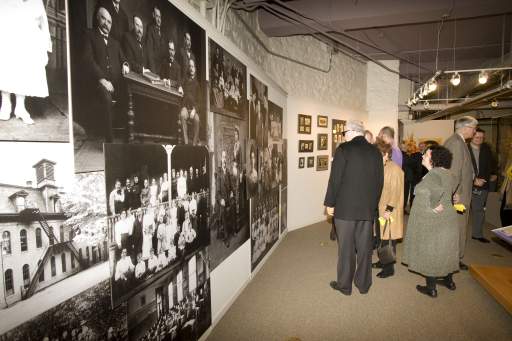
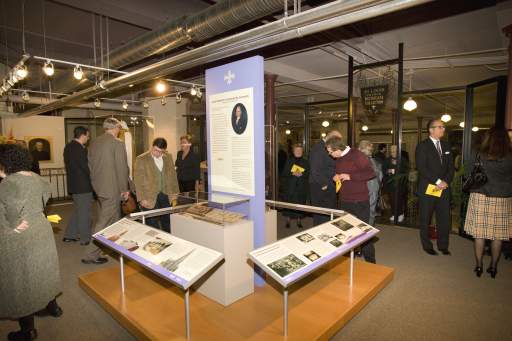
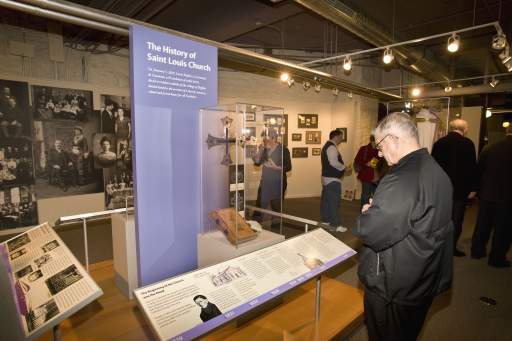
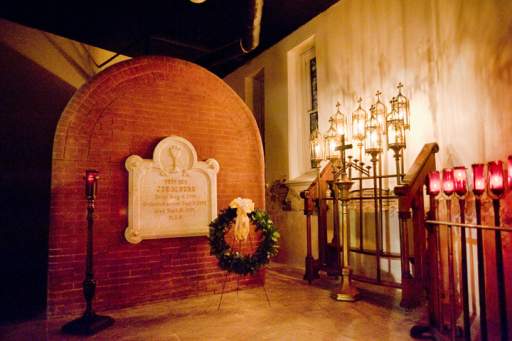

Kimball Organ
The Historic Kimball Organ was built in 1903 by the W.W.Kimball Company of Chicago, IL. Originally containing 30 stops with 33 ranks of pipes, the cost of the organ was $7,000. It was dedicated in concert on November 24, 1903 by Gaston Dethier, a famous organist based in New York City.
In 1952 and in 1987, the organ had major renovation work including various part replacements and new stops. As of October 1999, the organ has 2,600 pipes distributed over 44 stops (49 ranks).
William Kurzdorfer is the curator of this magnificent organ. His loving care and mechanical expertise maintains the organ to keep it sounding beautiful.
Former Pastors
Please pray for our former Pastors.
1829 - 1836
Reverend John Nicholas Mertz
1836 - 1843
Reverend Alexander Pax
1844 - 1850
Reverend Francis Guth
1850 - 1851
Reverend Joseph Raffeiner
1855 - 1861
Reverend William Deiters
1861 - 1862
Reverend J. E. Moshall
1862 - 1863
Reverend Francis Anthony Gerber
1864 - 1867
Reverend Sergus Schoulepnikoff
1867 - 1888
Reverend Joseph M. Sorg
1888 - 1916
Rt. Rev. Msgr. Dr. Paul Hoelscher
1917 - 1944
Rt. Rev. Msgr. Henry B. Laudenbach
1944 - 1948
Reverend Michael A. Anstett
1948 - 1964
Reverend Howard J. Schwartz
1964 - 1965
Reverend Clarence Ott
1965 - 1979
Reverend Alfred M. Mosack
1979 - 1995
Rev. Msgr. William A. Schwinger
1995 - 2002
Rev. Msgr. Robert A. Mack
2002 - 2004
Most Rev. Robert J. Cunningham, D.D., J.C.L.
2004 - 2023
Rev. Msgr. Salvatore Manganello, S.T.L, J.C.L.
Stained Glass Windows
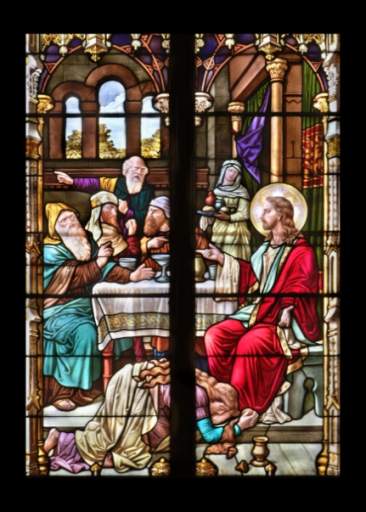
St. Mary Magdalene
Mary of Bethany, sister of Martha, is sometimes considered to be Mary Magdalene. Here we see the famed incident in which Mary has cried on the feet of Jesus while he was at supper and dries His feet with her hair. The irate apostle Judas is exasperated that she pours expensive perfume on Christ’s feet stating it should have been sold and the money given to the poor. Martha is in the background serving the guests. St. Mary Magdalene was told, “she has been forgiven much because she has loved much.”
This window is in memory of Christian Weyand who was born in Lorraine in 1826. He was the President of the Christian Weyand Brewery which stood opposite our church across Main Street. His son, Charles Weyand, was a founding member of the St. Louis Dramatic Circle, organized in 1885, to raise money for the building of our present church. Christian Weyand died in 1898.
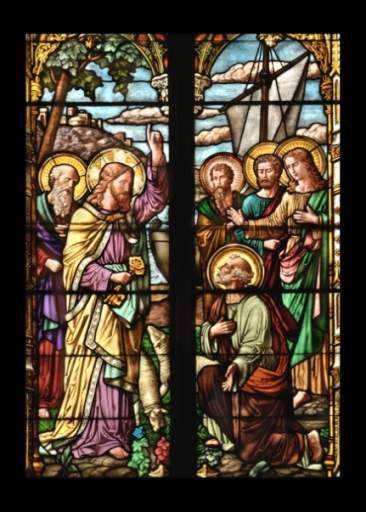
Conferral of the Keys on St. Peter
Jesus Christ conferred upon Peter the keys of the kingdom, establishing the Church upon Peter the Rock.
The doctrine of papal infallibility was proclaimed in 1870 by Pius IX. The scene of Peter receiving the keys was very common in Churches of this era. Peter kneels in respect indicating his response to Jesus’ question, “Whom do you say that I am?” “You are the Christ, Son of the living God.” This was a silent reminder to parishioners that the Church was entrusted to Peter and his successors after Christ’s death. The authority of the Pope, present successor to St. Peter, stems from this biblical event.
This window is in memory of Nicholas Ottenot, Mr. Ottenot was born in 1820 in Laneuville Au-Rupt, Lorraine. He was a loyal trustee of this parish during the difficulties with Bishop Timon and was an insurance and real estate agent and notary public. He died in 1887.
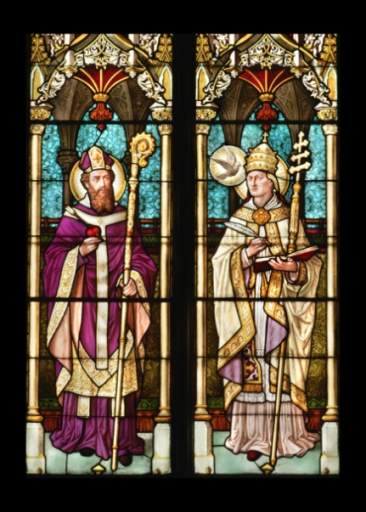
St. Augustine, Bishop and Doctor (354-430) St. Gregory the Great, Doctor (540-604)
St. Augustine was born in Tagaste, northern Africa. His father was pagan, his mother St. Monica, Christian. He was extremely intelligent and a bit on the wild side. As a university student, he abandoned the Christian faith of his mother and joined other religious movements, took a mistress and fathered a child. He taught rhetoric for many years in Africa, Rome and Milan. At Milan, after long years of incessant prayers by his mother, he returned to Christianity, and was instructed and baptized by St. Ambrose. He was later ordained a priest at Hoppoin North Africa and became Bishop there. He wrote voluminously in defense of Christianity.
In this remarkable window St. Augustine holds his identity symbol of a heart pierced by an arrow, the universal symbol of someone in love. It refers to St. Augustine’s passage from his confessions: “Thou has made us for thyself O’ Lord, and our hearts will ever be restless until they rest in thee.”
St. Gregory came from a wealthy patrician family of Rome, was educated there and served in the civil government. At about 30 years old he turned his home into St. Andrew Monastery and became a monk. Later ordained, he spent 8 years as papal ambassador to Constantinople. Upon his return, he resumed his monastic life. After seeing young Englishmen sold as slaves, he was determined to Christianize England. Gregory’s plans were interrupted when he was elected Pope in 590. He sent Augustine, the Abbot of St. Andres, to Canterbury, England and established Christianity there. He was an excellent preacher and writer, organizer and composer of Gregorian chants. He began the custom of 30 successive Masses for the dead called Gregorian Masses.
In this window, St. Gregory is shown wearing a processional cape, writing his book at the inspiration of the Holy Spirit, represented by the dove. On his head, he wears the triple crown representing the duties of the pope: to teach, govern, and sanctify.
This window was the gift of Charles Dearing. Mr. Dearing was born in Hesse -Darmstadt in 1850. He was a successful meat dealer on Allen Street and trustee of this parish. He died in 1939.
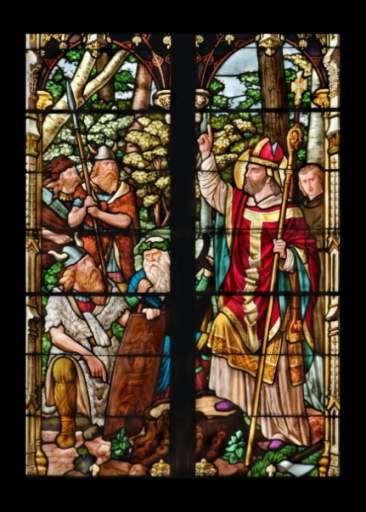
St. Boniface, Apostle of Germany (680-754)
St. Boniface was born in Devonshire, England and was schooled by the Benedictines and directed their school at Winchester. Ordained in 715, he wanted to be a missionary to Germany. He was sent there by Gregory II and was assistant to St. Willobrord. He was made bishop in 722 in Rome and was given protection by Charles Marlel. He became a success after he demolished the oak tree which was thought by the pagans to be God. He remained a constant missionary and was in Holland preparing for a confirmation when pagans attacked and murdered him. Pius IX put his feast in the universal calendar in 1874.
In his window, St. Boniface is wearing red vestments that indicate his murder as a martyr. He stands in triumph with one foot on the oak tree which he has just chopped down without any danger or harm to himself. “There is only one God and it isn’t this tree.”
This window is in memory of Joseph and Anna (Lautz) Krumholz. Mr. Krumholz was born in 1839, in Buffalo, N.Y. He was the Secretary of the Buffalo Gas Company. In 1890, he married his second wife, Anna Lautz, who was born in 1848. Mr. Krumholz died in 1907, three years after the death of his wife Anna.
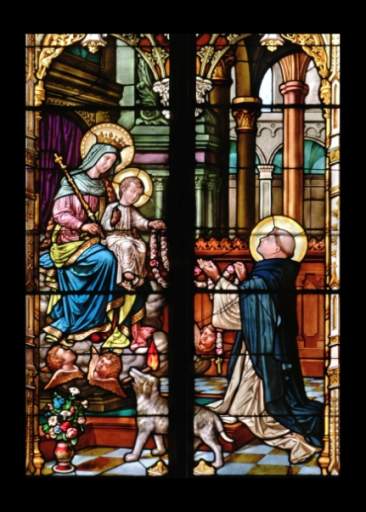
St. Dominic, Founder of the Dominicans (1170-1221)
Dominic Guzman was born in Carla Ruega, Spain. He studied at Palencia, was ordained priest and made Canon of Osima in 1199 and Prior of the Cathedral Canons. He preached against Albiegensian heresy, founded Dominican Friars to preach the Gospel, but lived in simplicity. Honorius III approved the Dominicans in 1215. The new order filled a great need of intellectual teachers clearly instructing in faith, but living in utter poverty in contrast to the rich clergy.
He is shown here receiving the rosary in the form of a garland of roses from the Blessed Virgin Mary and the Christ Child. The Latin term dominicanis (canis means dog) may be the reason St. Dominic is most often pictured with a dog with a burning torch in its mouth, representing the “Burning Truth”.
Gift of Joanna Haupelshofer, a native of Prussia, born in 1810. Mrs. Haupelshofer was the wife of Jacob Haupelshofer, born in Bavaria in 1815. He is listed as a peddler in the City Directory. Mr. Haupelshofer died in 1879. Mrs. Haupelshofer died in 1889.
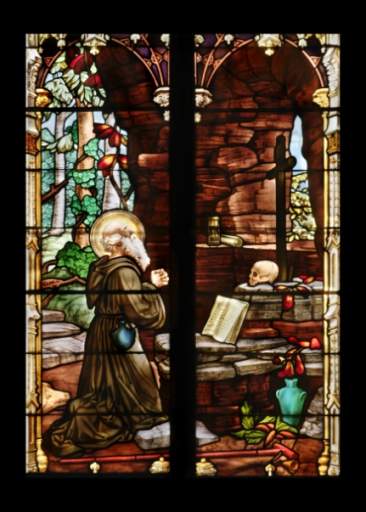
St. Anthony the Abbott (251-356)
St. Anthony The Abbott was also known as St. Anthony of Egypt and St. Anthony of the desert. He was born near Memphis in upper Egypt to wealthy parents and had a younger sister. His parents were already deceased when his conversion experience happened. He was late for Mass and entered the Church during the Gospel. The priest was reading, “If Thou wouldst be perfect, sell what Thou hast and give to the poor and then follow me”. These words so struck Anthony that upon returning home, he sold everything, put his sister in a convent, and went out to a graveyard in a desert cemetery to lie in solitude for many years, enduring fierce temptations.
In this window, the aged Anthony kneels in prayer before a wooden cross in his cave window. The skull represents death and the brevity of our earthly life as opposed to the endlessness of eternity.
This window is a gift from Anthony Neupert, who was born in Sauerhof, Bavaria in 1839. In 1861, he married Barbara Broezel, who was born in 1841. Mr. Neupert was President of the A. Neupert Paper Hanging Co. He also served the community in many roles including Secretary of the German Roman Catholic Orphan Asylum. In 1903, While on a tour of the Holy Land in 1903, Barbara Neupert died. Anthony died in 1905 in Munich, Germany while on a trip to his homeland.
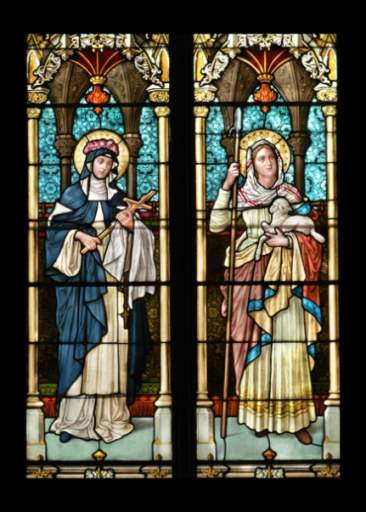
St. Rose of Lima (1586-1617) St. Genevieve of Paris (422-500)
Born in Lima, Peru, St. Rose was a remarkably beautiful woman, devout in childhood, and looked up to St. Catherine of Siena as a role model. She became a member of the Third Order of St. Dominic and wore the white habit, black mantle and veil of the Dominicans, but was not a nun. She resisted her parent’s designs for her to marry, and lived in a hut behind her family home. Here she meditated constantly on the sufferings of Christ crucified. She wore a crown of sharp spikes beneath her veil. Rose kept a flower garden, and by the sale of her roses, supported herself and was able to be generous to the poor. Rose of Lima died in 1617 in Lima and was canonized in 1672, the first canonized saint of the new world. She is patroness of South America. The crown of roses recalls her virginity, her occupation as a rose gardener and the heavenly crown for her wearing the spiked metal crown in honor of Christ’s passion.
St. Genevieve was born near Paris. When the famous Bishop, Germanus of Auxerre, visited her hometown, Genevieve was so impressed with his sermon that she consecrated herself to God when she was only seven years old. After her parents died, she moved to Paris and became a consecrated virgin. She was also a shepherdess, which is the reason for the lamb in her arms and the shepherdess staff.
During several sieges of Paris, St. Genevieve organized relief services and provided food. She interceded for the freedom of many captives. She was given the gift of prophecy and foretold the coming of the barbarian King Attila II and his Huns, but said they would bypass Paris and leave it alone. St. Genevieve is patroness of Paris and her prayers saved the city from destruction many times.
In memory of Genevieve Kraft, born in 1855 and died in 1884. Genevieve was the daughter of Frank J. Kraft born in Wangen, Alsace in 1821 and Anna Rebstock, born in 1823. Frank J. Kraft was the leading undertaker in the city and was appointed Overseer of the Poor. He was known for his generosity. He died in 1898.

St. Paul the Apostle
St. Paul in Tarsus, was strictly educated in Jerusalem as an observant Jew. He was roused to anger at the rise of Christianity, and held the coats of those who stoned St. Stephen to death. In this window, Paul is full of rage as he heads to Damascus with warrants to round up the Christians and kill them. Blinding light knocks him from his horse and blinds him. Christ speaks to him from the heavens. “Saul, Saul, why do you persecute me?” “Who are you, sir?” “Jesus of Nazareth. Go Straight Street in Damascus.” Paul did so and was instructed and baptized. He became the greatest Christian missionary and teacher, wrote 21 epistles, and his exploits were recorded in the acts of the apostles.
This window is the gift of Barbara Kleinschmidt. Barbara Rosa Kleinschmidt was born in 1839 in Karlstadt, Germany. In 1877, she married Theodore Kleinschmidt, who was born in Sachsenhausen, Germany in 1828. Mr. Kleinschmidt succeeded in founding a brewery and malting house in Buffalo.
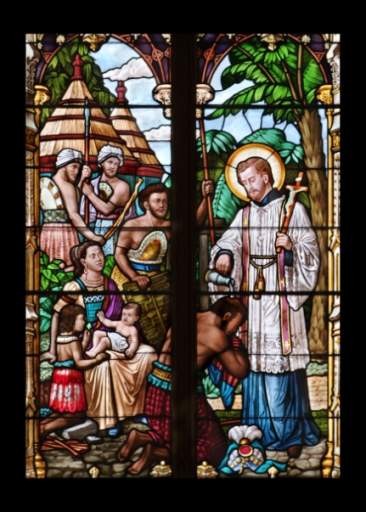
St. Francis Xavier, Jesuit Missionary (1506-1552)
St. Francis Xavier was a Spaniard. While attending the Sorbonne University in Paris with St. Ignatius Loyola, he became his disciple and was among the first seven Jesuits to take vows in Monmartre in 1534. He was ordained at Venice in 1537 and was sent to India in 1541 where he worked many years preaching and baptizing. He also worked in Japan, died on an island near China and is buried in Coa. St. Francis was an outstanding missionary and is known as the apostle of India and “Apostle of Japan.” He was canonized in 1622 and St. Pius X proclaimed him patron of the missions. Here, St. Francis is in his black Jesuit cassock with surplice and stole. He is shown in a remote part of India baptizing the natives.
This window is the gift of Xavier Dietsche. Mr. Dietsche was born in Amt Waldshut, Baden in 1836. He married Mary B. Rhode in 1861. He was a member of the building committee of our present church and a successful meat dealer at Elm and Burton Streets. He died in 1910.
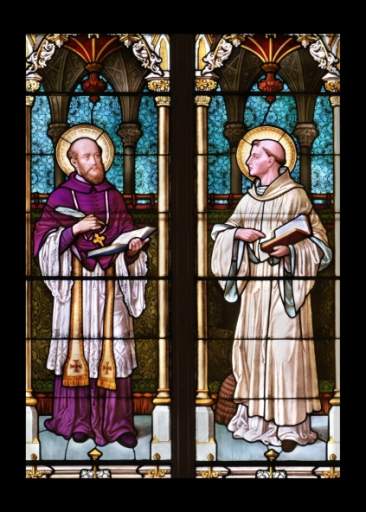
St. Francis de Sales St. Bernard of Clarivaux
St. Francis de Sales came from Savoy. He was educated at Paris and Padua University as a lawyer. Francis became priest in Hablais in 1593 and won thousands back to Catholicism by his kind and respectful approach. In 1602, he was made Bishop of Geneva, whose cathedral had been seized by the Calvinists and made headquarters of what is now the Presbyterian Church. He was a writer and journalist in defense of the church. His two books Introduction to a Devout Life and Treatise on the Love of God are classics of spiritual literature. St. Francis de Sales founded the Visitation Nuns in 1610 with St. Jane Frances de Chantal. He died in Lyons, France, December 28, 1622. He was canonized in 1665 and made doctor of the church in 1877 by Piux IX. He is patron of the Catholic press.
Born in Burgundy, France in 1112, St. Bernard and 31 friends entered the Cistercian Abbey of Citeaux. In 1115, he founded Clarivaux Abbey and became a powerful influence in the church reforms of his time. One of his monks became Pope Eugene III. Bernard preached the second crusade in which St. Louis’ grandfather took part, but it was a disaster. He was noted for his devotion to the Blessed Virgin Mary and his mystical writings. He is called “mellifluous doctor,” the teacher flowing with honey. The beehive behind him is an allusion to his title.
This window is the gift of Michael Fornesborn Mr. Fornes was born in 1845 and was a Supplier of Grocers. His wife Blondina Steffan Fornes was born in 1845. Mr. Fornes died in 1917. Mrs. Fornes died in 1913.
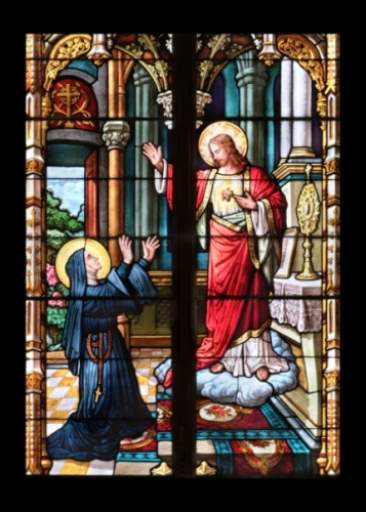
St. Margaret Mary Alacoque Visitation Nun (1647-1690)
St. Margaret Mary Alacoque comes from Burgundy, France. She became a nun in the Visitation order, founded by St. Frances de Sales and St. Jane Frances de Chantal. While adoring the Blessed Sacrament exposed on the altar of her convent chapel in Paray-le Monial, St. Margaret saw Jesus revealing his Sacred Heart, urging her to spread devotion to it everywhere. Jesus promised his blessings wherever his picture was honored, peace to families, refuge and mercy to sinners, increased fervor, and the grace of the final repentance to those who would go to confession and communion on the first Fridays of nine consecutive months.
This window was the gift of John Irlbacher. Mr. Irlbacher was born in Trichenricht, Bavaria in 1831. He was the founder of the firm Irlbacher-Davis Plumbing and Gas Fitting Co. He served as a captain in the 65th regiment which helped in the suppression of the rebellion in New York City in 1863. He died in 1899.
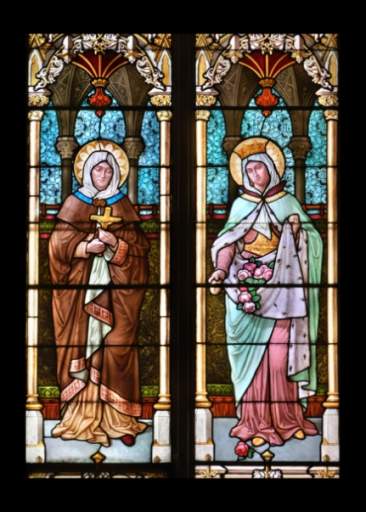
St. Odilia, Patroness of Alsace St. Elizabeth of Hungary
This window shows the beloved figure of a blind Benedictine nun who is revered by the Alsatians as their patron saint. Born blind, her father ordered that she be put to death. Her life was spared at the pleading of her mother on the condition that she not be raised in the area and that no one was to know her background. A peasant woman brought her to Baume, near Besancon. At the age of 12, she was put in a convent. Soon after while she was being baptized by Bishop Erhard, she regained her sight when she was touched by the Holy Chrism. When her father learned of this, he was infuriated. When Odilia’s brother arranged for her to come home, her father killed him. Her father repented and planned for Odilia to marry a German Duke but she refused and he was about to kill her when he changed his mind and gave her a castle at Hohenburg, now called Odiliensburg, for a convent. She died in 720 at her convent at Niedermunster and her shrine is a place of great pilgrimage. Her feast is on December 13th
Elizabeth was the daughter of King Andrew II of Hungary. She came to Wartburg Castle and was married to Louis, Son of Landgrave Herman. They were happily married and had four children. He was very religious and kind and built a hospital near her castle. Six years later, her husband went on a crusade with Emperor Frederick II, but died in Italy on the way to the Holy Land. When news of this reached the castle, Elizabeth and her children were thrown out and were received by the poor she had always helped. In 1228, she became a member of the third order of St. Francis at Marburg and looked after the poor and sick.
She is shown with roses falling from her mantle in reference to an event that happened while her husband was still living. She used to bring loaves of bread to the poor every day. Her husband met her on her charitable errand, asked her what she had hidden in her mantle and was astonished to see roses fall to the ground.
This window was given by the Lautz Family in memory of their mother Elizabeth Hiemenz Lautz. Elizabeth Lautz was born in 1814 in Dieburg, Germany and was the wife of William Lautz, born in 1815. She was known for her business acumen and encouraged her sons in their business endeavors. She died in 1887, one year after her husband.
Church Tours
Arrangements for church tours can be made by contacting the rectory.
Rectory Hours
Monday–Friday
9:00 AM – 3:00 PM
Rectory Contact
Phone: 716-852-6040
Fax: 716-853-9225
Email: parishoffice@stlouisrcchurch.org